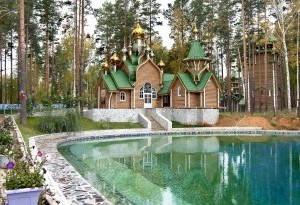Ganina Yama is a very significant site in Russian history

Ganina Yama is an old forest mine in the vicinity of Yekaterinburg, named after the contractor Gavriil (Ganya is diminutival name) who bought it somewhere in the 19th century. By the 20th century, the mine was already abandoned, only the pits of old mines and pits remained. It was here on the night of July 17, 1918 that Yakov Yurovsky, the organizer of the execution of the family of the last Russian emperor, ordered to bring the bodies to be dumped in a mine filled with water. The mine, however, turned out to be shallow. Regarding the further version, they diverge: either the remains were taken to the Porosyonkov Log ("Piglet’s Ravine") and buried there, or they were burned without any trace with fire and sulfuric acid on Ganina Yama. One way or another, the mine is involved in the last act of one of the most important dramas of national history.
Despite the tight veil of secrecy and the conspiracy of silence, the fact of burial was not concealed. Even in the remote 1970s, people came to the tract to honor the memory of those killed, and with the beginning of perestroika, the pilgrimage gradually became widespread. On July 17, 1991, the Yekaterinburg bishop gave a blessing to install a worship cross in this place. Ten years later, the Russian Orthodox Church canonized those shot in the basement of the Ipatiev House Nikolai Alexandrovich, Alexandra Feodorovna, Alexia, Olga, Tatiana, Maria and Anastasia as holy passion-bearers, and a monastery arose in Ganna Yama. Its full name is the male monastery of the Holy Imperial Passion-Bearers in the Ganina Yama gorge. Donated money for the construction of one of the key enterprises of the Sverdlovsk region - UMMC.
Now, among the rare pines behind the wooden fence, there are seven whole churches, also wooden. In the monastery there is a bell tower and everything that is necessary for the inhabitants and pilgrims - the chapel, the museum, the refectory, the governor’s house, as well as the tiled paths, benches, urns, artificial pond, brand new bronze monuments, covered wooden walkways, information boards and the gate tower with extensive asphalted parking for pilgrim buses.
The local churches were obviously built under the impression of the old Russian wooden architecture. Because of the novelty, livability and some overcrowding, these churches, made of neat rounded logs and covered with bright green artificial shingles, unexpectedly resemble a cottage village. However, the very mouth of Ganina Yama, where supposedly the bodies were dumped, still makes a strong impression: it is just a mouth filled with cheerful fresh grass and gently leaving into the abyss. It is surrounded by wooden covered rails, raised above the ground, with railings on which you instinctively immediately rely. Standing here even on a sunny day is chilly and somehow creepy - it seems that the death funnel can quietly and easily suck a living person.
Countless buses with pilgrims save from silence and tragedy. All sorts of people go to the royal passion-bearers: both humble women in headscarf, and girls selflessly photographing all around and themselves, and simple-looking men who came with the family exclusively for the company, and the harsh ideological bearded, and children, silent or noisy... Tourists in groups and singly, hurried and hovering, create an almost chaotic unceasing vivacity. The place is mortal - the place is very lively.
The living and the dead are incomprehensibly and clearly connected on stands with photographs on one of the walls. Many, many old black and white photographs - Nicholas II was a passionate amateur photographer. Family picnics, children on the shores of the Gulf of Finland, grand princesses in caps, boats, boulders, the sovereign himself, sitting on the fence in funny tennis shoes. Everything is very clear - this could be a photo album of a modern loving family on any social network. A bit naive, stylishly old-fashioned; if you just forget how it ended.
LOCAL FEATURES
The inhabitants of the monastery are not at all inclined to sentimentality and uncompromising in everything. For example, they are sure that the bodies of the murdered Romanovs were completely destroyed right here, at them, at “Holy Mine No. 7”, where stands an oak cross - a gift from the singer Vika Tsiganova and her spouse. According to their radical opinion, not those remains were found in the Porosyonkov Log, it's all a substitute for averting the eyes. And the Bolsheviks, who killed the king and the queen with children, were simply puppets, behind whose backs stood the World Forces of Evil.
Despite such a severe uncompromising, tourists are welcomed hospitably. On the territory of the monastery there is a cafe for pilgrims and tourists - with monastic bread, tea and pies.
HISTORY
In the XIX century there was a mine for the extraction of gold. The precious metal, however, was never discovered - iron ore was mined in the mine. Since the beginning of the XX century, the mine was in ruins. On the night of July 17, 1918, the bodies of 7 members of the royal family were thrown into the mine. In memory of this terrible event in 2000, a monastery was laid here.
In the XIX century, the mine was owned by the entrepreneur Gavriil, whose locals simply called Ganya. Hence the name of the mine - Ganina Yama.
In the place where the royal family was shot, the Temple-on-the-Blood, performed in the Russian-Byzantine style, was built.
Initially, the domes of all the churches of the monastery in honor of the Holy Royal Passion-Bearers were wooden, but later they were replaced with gold-plated ones.
Join our tours and take a look at this amazing attraction:
Excursions - www.uvisitrussia.com/day-tours/tours-to-yekaterinburg/
Tours - www.uvisitrussia.com/tours-to-yekaterinburg/



